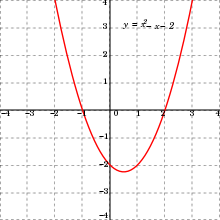
Back دالة تربيعية Arabic فانکشنی دووجا CKB Пĕр улшăнавçăллă тăваткалла функци CV Polynomial cwadratig Welsh Quadratische Funktion German Función cuadrática Spanish تابع مربعی Persian Fonction quadratique French Función cadrática Galician द्विघात फलन Hindi
In mathematics, a quadratic function of a single variable is a function of the form[1]
where is its variable, and , , and are coefficients. The expression , especially when treated as an object in itself rather than as a function, is a quadratic polynomial, a polynomial of degree two. In elementary mathematics a polynomial and its associated polynomial function are rarely distinguished and the terms quadratic function and quadratic polynomial are nearly synonymous and often abbreviated as quadratic.

The graph of a real single-variable quadratic function is a parabola. If a quadratic function is equated with zero, then the result is a quadratic equation. The solutions of a quadratic equation are the zeros (or roots) of the corresponding quadratic function, of which there can be two, one, or zero. The solutions are described by the quadratic formula.
A quadratic polynomial or quadratic function can involve more than one variable. For example, a two-variable quadratic function of variables and has the form
with at least one of , , and not equal to zero. In general the zeros of such a quadratic function describe a conic section (a circle or other ellipse, a parabola, or a hyperbola) in the – plane. A quadratic function can have an arbitrarily large number of variables. The set of its zero form a quadric, which is a surface in the case of three variables and a hypersurface in general case.
- ^ Weisstein, Eric Wolfgang. "Quadratic Equation". MathWorld. Retrieved 2013-01-06.







